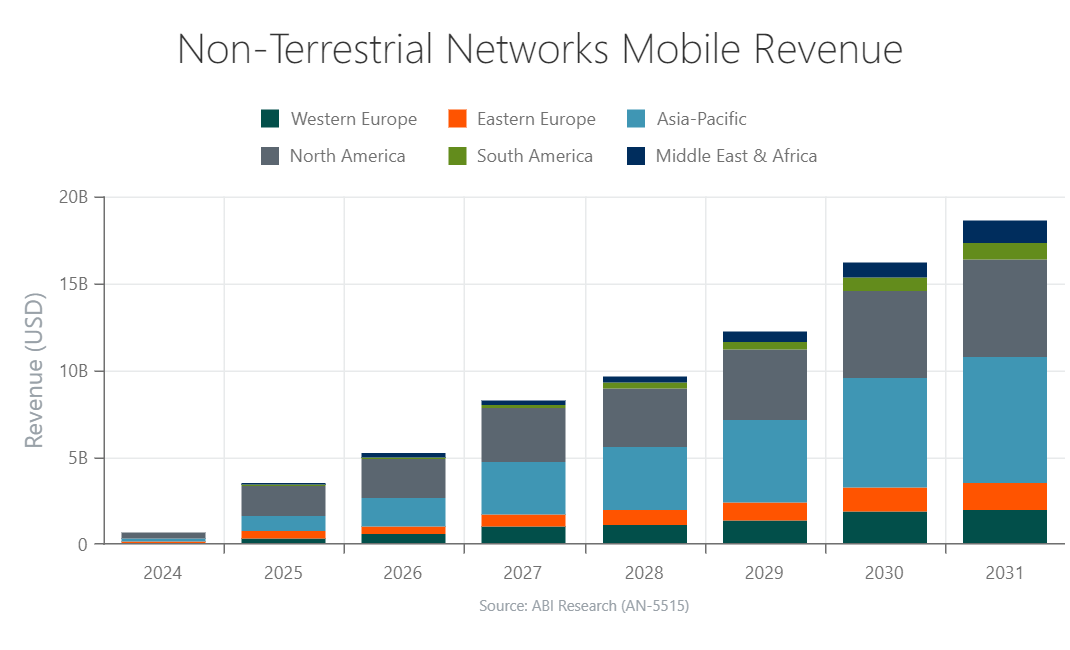Through vigorous standardization efforts, The Third Generation Partnership Project (3GPP) has laid the groundwork for satellite-based 5G connectivity using Non-Terrestrial Networks (NTNs). Leveraging satellites enables Mobile Network Operators (MNOs) to provide broadband coverage to those tough-to-reach areas, such as remote construction sites or crop fields for agriculture, as well as in underserved regions. As will be spelled out in this post, 5G from space can even help save lives by providing low-latency broadband to users in emergency scenarios when terrestrial networks are unavailable. To capitalize on this US$18 billion market opportunity that NTN mobile presents, everyone from smartphone manufacturers to Satellite Communication (SatCom) service providers, and from chipset vendors to network operators, have been busy integrating satellite communications into their 5G solutions and striking numerous partnerships to strengthen their offerings.

Benefits of Satellite Communications in 5G Services
5G services that run on NTN satellite networks provide end users with several key benefits. This section dives into some of them.
Integrated Network Architecture
Satellites have been a key trend in 3GPP standards development for 5G NTN services. This has ensured that, through a satellite link with NodeBs base stations, the satellite infrastructure is directly connected to cellular network infrastructure. From there, the NodeBs base stations connect to the Evolved Packet Core (EPC), and then ultimately, the 5G Core (5GC).
Flexible Space Deployment
MNOs can use Low Earth Orbit (LEO), Geostationary Orbit (GEO), and Medium Earth Orbit (MEO) satellite constellations from space as repeaters, which then transmit signals to ground-based NTN NodeBs (gNBs). At some point, these satellite constellations will serve as base stations (regenerative mode) for 5G networks.
IoT Service Ubiquity
By leaning on adapted cellular Internet of Things (IoT) protocols (Narrowband IoT (NB-IoT) and LTE-M), 5G narrowband NTN satellite networks deliver low data-rate coverage (200 Kilohertz (kHz)) communications. For the IoT, this typically falls under Machine-to-Machine (M2M) communications; for mobile devices, it’s Short-Message-Service (SMS) and Push-to-Talk (PTT).
Ubiquitous Broadband Services
When used with 5G New Radio (NR), non-terrestrial networks will deliver broadband communications for high data-rate communications (e.g., video, voice, and content streaming) at 5 Megahertz (MHz) to 20 MHz.
Service Continuity
If a cellular network goes down during an emergency response, it could be the difference between life and death. Satellite-based 5G services ensure that connectivity is not uninterrupted during natural disasters, military conflicts, and other unforeseen events that damage terrestrial cellular infrastructure. Service continuity is also crucial in mission-critical enterprise applications (e.g., mining, agriculture, remote industrial sites), the healthcare sector, and financial services.
Service Scalability
Non-terrestrial 5G networks align with traffic management strategies, facilitating seamless traffic offloading between terrestrial and non-terrestrial communications. This approach enhances communication efficiency, leveraging the extensive coverage of NTN gNB and base station offloading for improved system performance.
Satellite Use Cases for 5G Connectivity
3GPP Release 17 was a major breakthrough for 5G satellite connectivity, as it broke the barrier between commercial space and terrestrial mobile communications networks. This development, in ABI Research’s assessment, will result in more widespread use of SatCom services within consumer devices and carve out new ways to use mobile communications.
For starters, users will no longer need to purchase expensive dedicated satphones. Instead, smartphone manufacturers can partner with satellite operators to offer satellite 5G connectivity within their consumer-grade devices. However, high-bandwidth data streaming and conventional calling are not yet feasible opportunities, as satellite networks can only work with IoT-NTN networks on a mass scale. For this reason, the first wave of satellite-to-mobile smartphones will be associated with low data rate text messaging and emergency services (e.g., vehicular crashes).
NR-NTN broadband technology will significantly widen the market opportunity for 5G-supported satellite networks because it provides higher data rates and Internet access. ABI Research anticipates that 5G NR-NTN networks will mainly be used for coverage and outdoor applications. For example, the automotive industry will experience a noticeable change as NR-NTN networks can potentially support autonomous driving, advanced mapping, weather updates, traffic information, and emergency services. Besides vehicles, there will be plenty of new use cases for 5G NR-NTN in consumer (smartphones) and enterprise IoT devices.
Furthermore, satellite-based smartphones can completely change the telecoms industry by developing a union between consumer smartphones and the telco network. Unmodified smartphones are being provided with Long Term Evolution (LTE) 4G and 5G broadband services through collaboration among satellite operators and MNOs. AST SpaceMobile, Lynk, and SpaceX (Starlink) come to mind as some notable SatCom operators making moves. Needless to say, satellite 5G is a key enabler in allowing MNOs to expand their cellular broadband coverage in areas where coverage is poor or non-viable, as well as to eradicate cellular dead zones.
5G Satellite-to-Mobile Market Update
As the satellite 5G ecosystem picks up pace, two distinguished segments have come to the fore: the space segment and the NTN ground segment. The space segment consists of satellite network operators and service providers, such as AST SpaceMobile, BeiDou, EchoStar, Globalstar, Inmarsat, Iridium, Lynk, and SpaceX/Starlink.
Meanwhile, the NTN ground segment embodies smartphone equipment manufacturers, solutions providers, chipset vendors, and network operators. Examples of these companies include Apple, Bullit Group, Huawei, MediaTek, Motorola, Qualcomm, Samsung Electronics, Skylo, and ZTE.
While these two segments are distinguished, satellite integration into the 5G network architecture results in numerous partnership opportunities between satellite operators, MNOs, User Equipment (UE) manufacturers, and solution providers. These kinds of collaborations, such as T-Mobile and SpaceX/Starlink or Huawei and ZTE with BeiDou, mark the dawn of a broader satellite-to-mobile era. In turn, cellular connectivity will become accessible to users in even the most remote or underserved regions on the planet.
Learn more about this topic in ABI Research’s The Role of Satellite in 5G: Non-Terrestrial Networks (NTN) Mobile report. This content is part of our 5G & Mobile Network Infrastructure and Satellite Communications research services.






